the history of yeovil's pubs
PUBS HOME PAGE |
PUBS INTRODUCTION |
PUBS BY NAME |
BEERHOUSES |
castle Inn / hotel
7 Middle Street
Before its demolition in 1927 for street widening the Castle Inn (shown as 'C' on the map below) was Yeovil’s earliest house. It was, in part, 13th century and had been an old medieval chantry property – a chantry being a fund to pay for a priest to celebrate daily Masses, generally for the soul of the deceased donor. Chantries were usually endowed with lands given by the donors, the income from which maintained the chantry priest. It was one of seven chantry properties surviving the Great Fire of Yeovil of 1449.
When it first opened as licensed premises, probably before 1580, it was called the Hart or the White Hart. In his will of 24 August 1580, woollen draper Gyles Hayne wrote "... All that my Burgage or Tenemente, and Gardeyne to the same belonginge scituate and beinge in Pitlane nexte the Harte within the Borough of Yeavell foresayde...".
Later it was known as the Higher Three Cups or Upper Three Cups, until about 1750, to distinguish it from another old medieval pub in Middle Street called the Three Cups, itself later renamed as the George.
Although it was one of Yeovil's four coaching inns, it is unlikely that a coach and horses would be driven through the central arch it since the road at this point was just twelve feet wide and there wasn't enough space in the Castle's rear yard to turn a coach - the stables and coach house were almost certainly off-site.
In 1618 an order
was made that
only nine
licensed
premises be
allowed in the
borough (that is
the town, not
that part of
High Street
today called the
Borough) and
two outside,
with the rest
being
'suppressed'.
The White Hart /
Castle Inn was
likely one of
the nine
'allowed'
premises.
Few of the early
licensees are
known but the
earliest appears
on a trade
token. Most
Yeovil
trade
tokens were
issued by
tradesmen
following the
death of Charles
I in 1649 in
order to
overcome the
lack of small
change in
general
circulation.
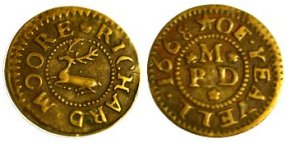 No
copper coinage
was minted
during the
Commonwealth and
the resulting
paucity of small
coinage was met
by independently-produced
and completely
unauthorised
tokens of brass
or latten
(copper alloys
similar to
brass). In 1672
farthings were
minted in the
reign of Charles
II with the
consequent
demise of trade
tokens.
A trade token
worth a
farthing,
photographed
here (but
reproduced much
bigger than life
size - it is
actually only
about 12mm in
diameter),
probably from
the White Hart
dated 1668,
depicts a hart
on the obverse,
together with
the licensee's
name, ''Richard
Moore'. On the
reverse is
inscribed 'of
Yeavell - 1668 -
M.R.D.'. Tokens
usually had
three initials,
representing the
surname and two
Christian names
of the issuer
and his wife.
No
copper coinage
was minted
during the
Commonwealth and
the resulting
paucity of small
coinage was met
by independently-produced
and completely
unauthorised
tokens of brass
or latten
(copper alloys
similar to
brass). In 1672
farthings were
minted in the
reign of Charles
II with the
consequent
demise of trade
tokens.
A trade token
worth a
farthing,
photographed
here (but
reproduced much
bigger than life
size - it is
actually only
about 12mm in
diameter),
probably from
the White Hart
dated 1668,
depicts a hart
on the obverse,
together with
the licensee's
name, ''Richard
Moore'. On the
reverse is
inscribed 'of
Yeavell - 1668 -
M.R.D.'. Tokens
usually had
three initials,
representing the
surname and two
Christian names
of the issuer
and his wife.
The building had a good arched doorway with Gothic-style hood moulding and on the upper floor a fine two-light traceried window, one three-light and one four-light stone mullioned windows. The arched doorway led through to extensive stabling, housing a large number of horses, as well as a large yard at the rear of the premises, as seen on the map below.
In his will of 1828 William Row of Lyde stated ".... all that my Messuage or Dwelling House and Inn called the Castle in Middle Street in Yeovil aforesaid with the rights members and appurtenances to the same respectively belonging....".
During the 1850’s a daily stagecoach, known as Edward’s Omnibus, left from the Castle to Bath and Bristol. The Castle itself had a large yard and extensive stabling to its rear. It was one of the first of Yeovil's premises to advertise a motor car for hire as well as a lock-up for guest's bicycles.
By the 1890s the Castle Hotel was a tied house of the Royal Osborne Brewery, with a long lease owned by Earle Vincent. When Vincent died in 1893 his estate was sold off the following year which included "the Castle Hotel.... let to Mr John Wilkins."
|
From the Western Gazette, Friday 18 March 1927 Ancient Yeovil HostelryThe Castle Inn to be DemolishedSite Wanted for ShopsArch and Early Windows to be Preserved
"The next few weeks will see the passing of one of the two oldest buildings in Yeovil, the Castle Inn in Middle Street, which is to be demolished to provide a site for shops. Anciently the residents of one of the priests serving one of the Chantry is attached to the parish church, the building has long been one of the greatest objects of interest to the antiquarian and visitor alike, for it possesses a XV century arch and several early windows. These, through the kindness of the new owner, are to be removed and preserved, together with any other portions of the ancient building which may be of interest. The Library Committee reported to the Town Council on Monday evening that Mr D Overall, the new owner of the Inn, had made an offer to present to the town the old arch, window, and any other antique portion of the building the Council might wish to preserve if they were removed. The Committee recommended that this offer be accepted with thanks, and stated they were arranging for the removal of these portions of the building at the appropriate time.
Mr AHJ
Stroud,
on
behalf
of the
Library
and
Museum
Sub-Committee,
said
they all
regretted
the
disappearance
of these
links
with old
Yeovil,
but it
was
inevitable
in view
of the
narrowness
of their
streets
and
modern
traffic.
There
were
excellent
photographs
of the
Inn, and
these
were
being
kept
carefully
preserved.
The Inn
stands
in the
narrowest
part of
the main
street
at
Yeovil,
which
also has
another
ancient
hostelry,
known as
the
George
Hotel.... The Mayor said, on behalf of the Bench, he wished to thank Mr Mayo's clients for treating the matter in the way they had, and also for handing over the best of the relics of the old building to the Museum Committee. They all, he thought, would regret such an ancient place should have to come down, but it would affect a considerable improvement to Middle Street. "In not applying for the renewal of the licence," the Mayor said, addressing Mr Mayo "Your clients are doing a very good thing, and treating the matter in a very nice way."
|
![]()
The first licensee of whom there is any personal information was John Thomas who was born about 1786 in Stockland, Dorset. He was listed as the licensee of the Castle in Robson's Directory of 1839, listed as a victualler in the 1841 census and was listed in Pigot's Directory of 1842. In the 1841 census he is listed with Louiza Lowman, a female servant who may actually have been his daughter. In July 1844 Louisa married William Smith who was to become the licensee of the George Hotel across the road. By 1851 he was living with Louisa and William as a retired innkeeper in Middle Street. He lived with them until his death in 1867.
After John Thomas retired during the 1840's, the license of the Castle was taken on by Joseph Dean. The Western Gazette noted in 1848 "Joseph Dean (late of the King's Head Inn) informs his friends that, in consequence of the site on which the King's Head premises are situated being required for the new Town Hall and market, he has purchased the stock, &c., of Mr John Thomas of the Castle Inn and will succeed to the business there at Lady-day next."
Joseph is first noted in Hunt's Directory of 1850 and in the 1851 census he is shown as a 40-year old licensed victualler from Branscombe, Devon, with his wife, Jane, and a house servant. Joseph died in 1860 and in the 1861 census Jane is shown as a 53-year old widow and inn keeper at the Castle with her 28-year old niece, Ann Billing, working as a bar maid.
The next licensee, George Ring, was born about 1816 in Martock and is noted as the licensee as early as 1866 in Kelly's Directory. The 1841 census finds him, a glove cutter, living in the lodge of Barwick House with his wife Salena and their baby son, also George. They were still living in Barwick House Lodge ten years later and George was described as a glover. Selina died in the summer of 1858 and by 1861 George and five of his children were living with a housekeeper in Ebenezer Row, a row of cottages in lower Middle Street, near to where Poundland's shop is today. George's occupation was given as leather glover. Kelly's Directory of 1866 listed George as licensee of the Castle and in the 1871 census George was listed as a 55-year old innkeeper and was living at the Castle with a new wife, Jane, some eleven years his senior. By 1881 George, now aged 64 and listed as a glove-cutter and publican was living at the Castle with his third wife, 50-year old Sara.
John Wilkins was born about 1826 in North Cadbury. In 1841, at the age of 15, he was listed in the census as a farmer and head of the household with his two younger sisters and younger brother; they were all living in the house of John Court, an agricultural labourer, in Galhampton, North Cadbury. The next time John appears in the records is in the census of 1861 where he is a 35-year old dairyman living in Church Farm Dairy Cottage, Corton Denham. John was living with his 22-year old Yeovil-born wife, Mary, and three children two of whom were certainly too old for Mary to have been their mother. The scene was pretty much the same by 1871 except everyone was ten years older. The 1881 census saw the family living in the Dairy House at Wyke Farm, Sherborne where John was still a dairyman. According to the birthplaces of some of their children, the family had moved around through the years including stops at Corton Denham, Mudford and Chilthorne Domer. In 1889, Kelly's Directory listed John as hotel keeper of the Castle Inn with Mary and five of their children. John was now aged 65 and, having retired from being a dairyman, followed many men's dream of becoming an innkeeper. In 1897 John was still listed as licensee Kelly's Directory but he died in the summer of 1900. Mary left the Castle almost immediately and in 1901 she was licensee of the Crown Inn in Huish with a son and daughter.
John White was born around 1862 in West Coker, son of labourer Sidney White and his wife, Ellen. By the time he was 18 in 1881 John, still living at home, was a coachman domestic servant. By 1891 John had married and he and his Yeovil-born wife, Priscilla, lived in Barwick with their three young children. John described his occupation as general servant. By 1901 John had left service and was listed in the 1901 census as the hotel proprietor of the Castle Hotel with Priscilla and three of their children the eldest of whom, Ada, worked as a barmaid. John was still at the Castle in 1907, but by 1911 he was licensee of the Globe and Crown in South Street.
William S Hardy
was born about
1866 in Yeovil
was the son of
farmer George
Hardy and his
wife, Ann. In
1871 the family
lived in East
Lydford, some 13
miles to the
north of Yeovil.
By 1881 Ann had
died and the
family moved to
Yeovil where
George was
employed as a
commercial
traveller for
one of the
breweries while
15-year old
William was
unemployed.
During the next
decade William
married and by
the 1891 census
he was living
with his wife,
Annie, and their
two baby sons at
48 Queen Street.
William's
occupation was
given as a wine
and spirit
cellarman and
Annie was a
glover. Ten
years later and
William and
Annie now had
five young boys
and were living
in Camborne
Grove. William
was still a wine
merchant's
cellarman,
however by 1911
he was the
manager of the
Castle Hotel and
Annie was the
manageress. By
1916 William was
licensee of the
Butchers Arms.
map
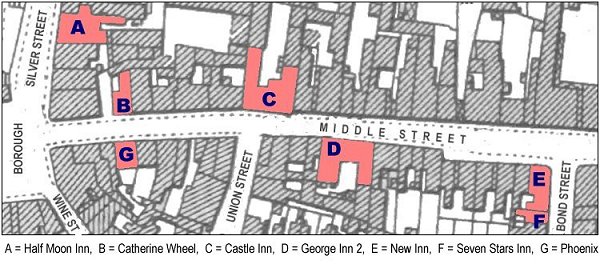
gallery
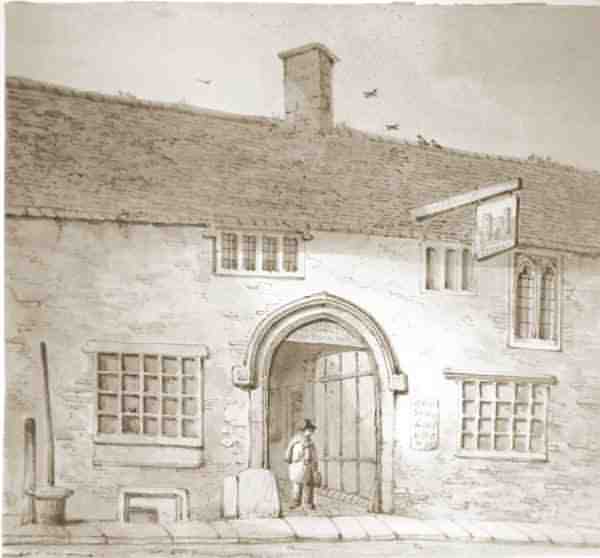
A sketch of the Castle Inn, drawn in 1847 in pencil and sepia watercolour by William Walter Wheatley (1811-1885). Compared with the later photographs shown below, Wheatley's representation is somewhat condensed.
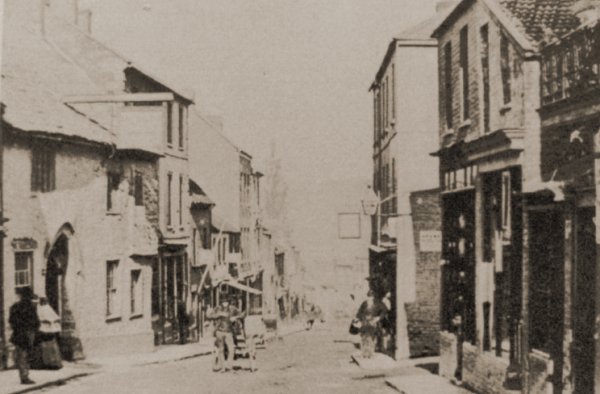
This sepia-toned photograph looking east along Middle Street dates to about 1875 and is probably one of the earliest photographs of the Castle Inn, seen at left. The house and herbal shop of murderer Robert Slade Colmer was the three-storey building next to it - the building where the murder of Mary Budge took place!! This is also the only photograph I know of that shows the original narrow entrance to Union Street opposite the Castle Inn. Note also the stovepipe hat of the man pausing with his barrow in the centre of Middle Street. The tiny house seen immediately above this man was Thomas Hayward's beerhouse.
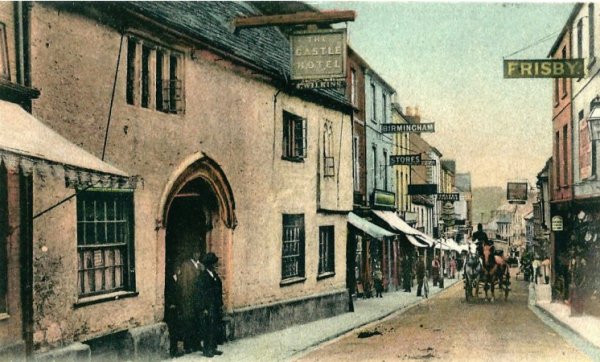
From my
collection. This
photograph
features in my
book "A-Z
of Yeovil"
This hand-coloured postcard was post-marked 1904 but the original photograph actually dates to about 1890 when the licensee was John Wilkins and his name appears under the Castle Hotel sign that projects into the road at high level.
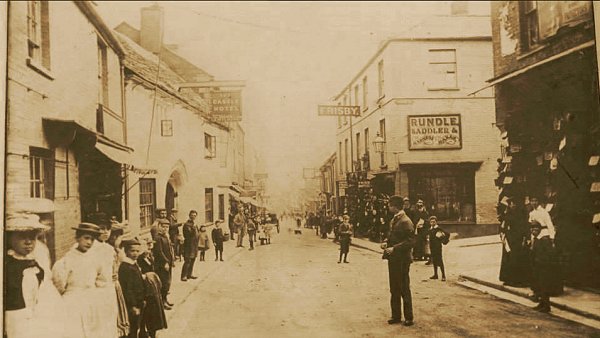
This photograph probably dates to about 1880 when John Rundle was the saddler and harness maker whose shop is at right, on the corner of Union Street, opposite the Castle Hotel.
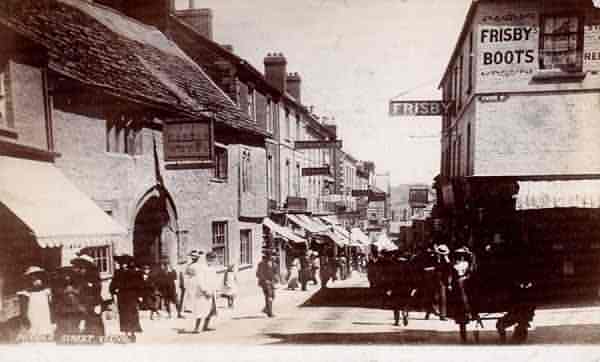
A postcard of Middle Street, featuring the Castle Inn opposite the entrance to Union Street. This postcard was used in 1904.
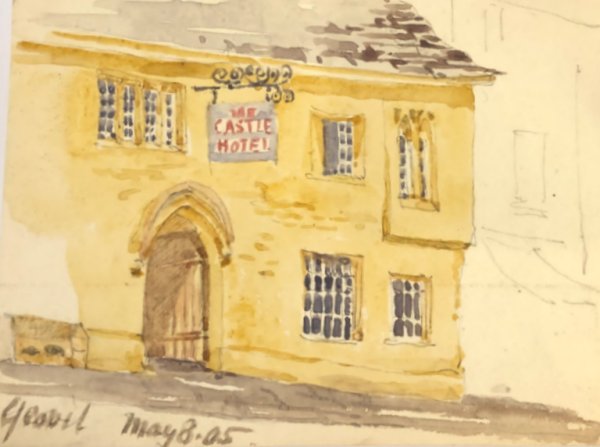
From my
collection
An original unsigned watercolour of the Castle Hotel, dated 8 May 1905.
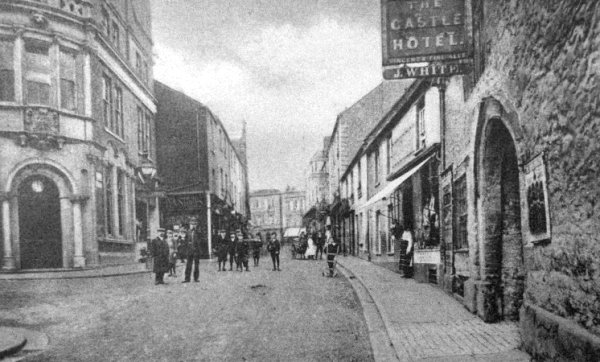
The Castle Hotel in 1905, when John White was Licensee.
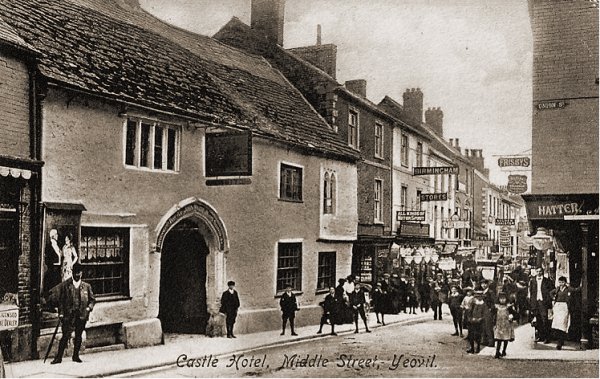
From my
collection. This
photograph
features in my
book "Lost Yeovil"
A lovely sepia-toned postcard taken at about the same time as the previous photo when John White was licensee - could that be John posing outside the hotel? Note the proximity to Union Street at extreme right.
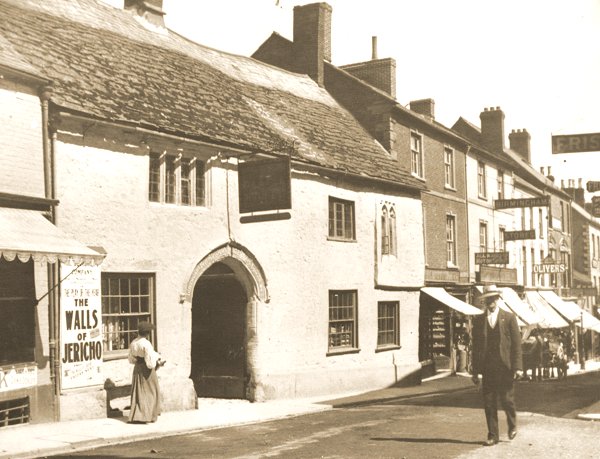
The Castle Hotel photographed in 1907.
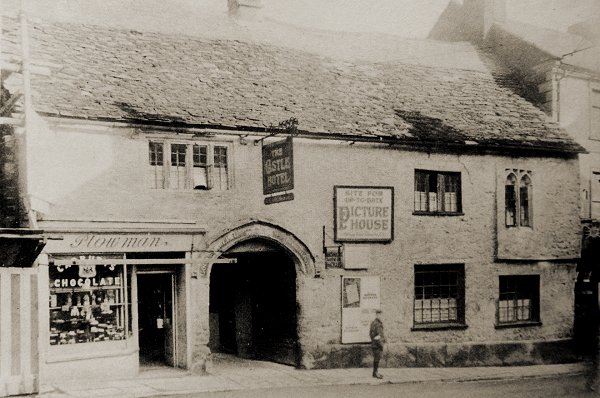
This photograph was taken in the early 1920's (about the time Stanley Cook was Licensee) as there is a poster indicating that the pub was to be demolished and the site to be used for an 'Up-to-Date Picture House'. In fact this did not materialise and after the pub was demolished in 1927 it was replaced by shops. Notice that since the previous photograph, Plowman's confectioners shop has been inserted into the Castle Inn building - a bit like the shops that were inserted into the frontage of the Mermaid Hotel at about the same time.
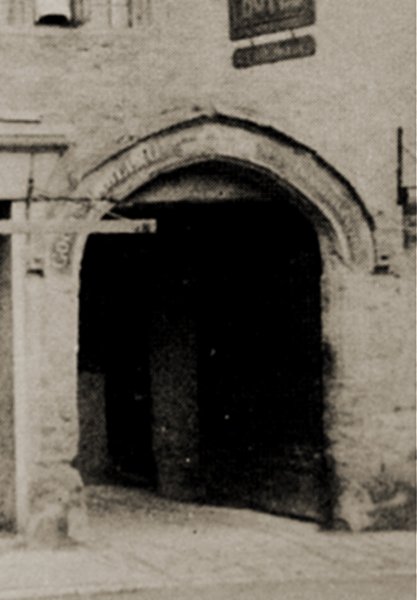
Enlarged from the previous photograph, this is also the best photograph of the Castle's porte-cochere, or archway. It is unlikely that a coach and horses would be driven through it since the road at this point was just twelve feet wide and there wasn't enough space in the Castle's rear yard to turn a coach. Although it was one of Yeovil's four coaching inns, the stables and coach house were almost certainly off site.

Taken about the same time as the previous photograph, this view looking east along Middle Street is almost identical to the first photograph in this series except that the Castle Inn is probably the only building that hasn't been rebuilt or drastically altered in the intervening years.
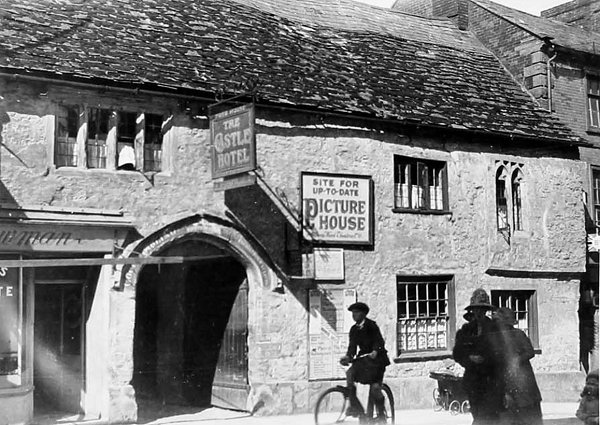
Probably one of the last photographs of the Castle Hotel taken before its demolition in 1927.
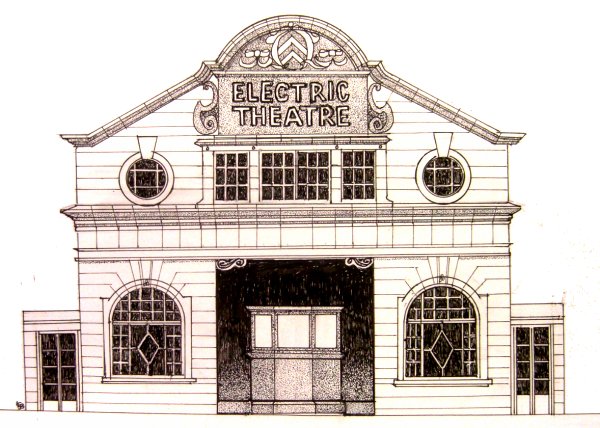
The proposed new 'Electric Theatre' cinema that was supposed to replace the Castle Inn. Designed by Yeovil architects Petter & Warren for Albany Ward Theatres in 1919.
licensees
as the
Hart / White
Hart
pre-1580 – Alexander Keele (will of Gyles Hayne)
1580 –
Gyles Hayne
1668 – Richard
Moore (named on
a trade token -
see above)
1677 – Mary
Moore (Lease)
1679 – Samuel
Nixon (Lease)
1691 – Benjamin
Snooke (Lease /
Mortgage / Bond)
as the
Higher Three
Cups
1733 – The Three
Cups, late
Pittard
1743 – John
Piddle –
innholder
(Lease) noted as
the Higher Three
Cups
1756 – Joseph
Hodge –
innholder
(Lease) noted as
the Higher Three
Cups
1760 – Joseph
Hodges (Poor
Rate Book)
1770 – Joseph
Hodges –
Innholder (Will)
1771/2 – Joseph
Hodges (Junior)
– innholder
(Claim under
Will)
as the
Castle Inn
1768 – Joseph
Hodges
(Insurance
Document) noted
as the Castle
Inn
1785 – Row,
owner - Hewlett,
occupier (Land
Tax Returns)
1798 – William Rowe,
owner (Land
Tax Redemption)
1822 – Elisha
Court (Pigot’s
1822 Directory)
listed as Castle
1824 – Elisha
Court (Pigot’s
1824 Directory)
listed as
Castle, Middle
Street
1827 – Elisha
Court (1827
Jurors List)
1828 – William
Row, proprietor
- E A'Court,
occupier (Land
Tax Returns)
1830 – Elisha
A’Court (Pigot’s
1830 Directory)
listed as
Castle, Middle
Street
1839 – John
Thomas (Robson’s
1839 Directory)
listed as the
Castle
1841 – John
Thomas –
Victualler (1841
census) pub not
named
1842 – John
Thomas (Pigot’s
1842-4
Directory)
listed as the
Castle
1848 – Joseph
Dean - bought
stock, etc.,
took over on
Lady Day
(Western Gazette)
1850 – Joseph
Dean (Hunt & Co
1850 Directory)
1851 – Joseph
Dean - Licensed
Victualler (1851
census) listed
as Castle Inn
1852 – Joseph
Dean – Inn
Keeper (Slater’s
1852 Directory)
listed as the
Castle
1859 – Joseph
Dean (Harrison,
Harrod & Co 1859
Directory)
1861 – Jane Dean
(52 year old
widow of Joseph
above) – Inn
Keeper (1861
census)
1861 – Mrs Jane
Dean (Kelly's
1861 Directory)
1866 – George
Ring (Kelly's
1866 Directory)
1871 – George
Ring – Innkeeper
(1871 census)
–age 55 with
wife Jane age 66
1875 – George
Ring (Kelly's
1875 Directory -
Hotels & Inns)
1881 – George
Ring – Glove
Cutter &
Publican (1881
census) listed
as Castle.
1889 – John
Wilkins (Kelly’s
1889 Directory)
listed as Castle
Inn
1891 – John
Wilkins – Hotel
Keeper (1891
census) listed
as the Castle
Inn
1895 – John
Wilkins (Kelly’s
1895 Directory)
listed as Castle
Inn
1897 – John
Wilkins (Kelly’s
1897 Directory)
listed as Castle
Inn
1901 – John
White – Hotel
Proprietor (1901
census) listed
as the Castle
Hotel.
1905 – John
White - from
dated photograph
above.
1907 – John
White (Kelly’s
1907 Directory)
1909 – Edward
James Slann - Manager
- License
transfer (Borough
Petty Sessions)
Messrs Knight
& Co, owners
1911 – William
Hardy - Manager (1911
census)
1912 – William S
Hardy – Manager
(Yeovil
Directory 1912)
1914 – William
Hardy (Kelly’s
1914 Directory)
listed as Castle
Inn.
1916 – Joseph
Tucker Brice
(Kelly’s 1916
Directory)
1923 – Stanley
Cook (Kelly’s
1923 Directory)
listed as Castle
Inn
1926 – Building demolished.
documentation
|
1677 |
Lease and Release - 16/17 July 1677 - Richard Thomas et al, Trustess of Merchant Company of Taylors in the City of Wells - Lease and Release to Mary Moore |
|
1679 |
Lease - 19 September 1679 - William Webb and Mary his wife, to Samuel Nixon, lease for 99 years. |
|
1691 |
Lease - 14 February 1691 - William Webb, cooper, of Yeovil, and Mary his wife, to Benjamin Snooke - messuage in Middle Street. |
|
1691 |
Mortgage - 16/17 February 1691 - William Webb and Mary his wife to Benjamin Snooke. |
|
1691 |
Bond - 17 February 1691 - William Webb / Benjamin Snooke. |
|
1693 |
Bond - 20 May 1693 - Bond for £10. Mariam Webb / Benjamin Snooke, mercer. |
|
1693 |
Lease and Release - 3/4 July 1693 - Richard Moore to Mary Webb, lease and release with affidavit. |
|
1694 |
Bond. 23 May 1694 - Arthur Eves, glover / Benjamin Snooke, mercer. |
|
1694 |
Mortgage - 23 May 1694 - Arthur Eves, glover of Yeovil, and Mary his wife / Benjamin Snooke. Messuage with garden in Pitt Lane, otherwise Middle Street, sign of the Hart, heretofore in possession of Richard Moore |
|
1696 |
Feoffment (a transfer of land or property that gave the new holder the right to sell it as well as the right to pass it on to his heirs as an inheritance), 26 March 1696 - of Arthur Eves and Mary his wife to George Arthur. |
|
1696 |
Lease / Sale - 26 March 1696 - £560 - Arthur Eves, glover of Yeovil and Mary his wife / George Arden of Corsham, Wilts, haberdasher, - messuage - the sign of the Hart, and garden in Pitt Lane or Middle Street heretofore in the possession of Richard Moore, decd. now Arthur Eves. |
|
1696 |
Sale - 26 March 1696 - Arthur Eves, glover of Yeovil, and Mary his wife to George Arthur, haberdasher of Corsham, Wilts, House or Inn 'The Hart' and garden in Pitt Lane or Middle Street - £160 - Signed Arthur Eves, Mary Eves |
|
1742 |
Lease and Release, 20/21 January 1743 - George Jones and Robert Seymer and James Seymer. |
|
1743 |
Bond, 21 January 1743 - George Jones to Robert Seymer to indemnify claim of dower. George Jones of Baltimore, Maryland, planter, to Robert Seymer of Bell Challwell, Dorset, for £50, reciting lease and release 20/21 January 1743 of messuage called the Hart and now The Higher Three Cups. |
|
1743 |
Lease and Release 25/26 January 1743 - George Jones, Maryland, planter, Robert Seymer, Bell Challwell, Dorset, gent, - Higher Three Cuppes and one garden in Pitt Lane otherwise Middle Street, now held by John Piddle, innholder. |
|
1743 |
Occupier of Archer's Three Cups - Rate Book |
|
1746 |
Lease and Release - 29/30 September 1746 - Robert Seymer of Bell Challwell, Dorset, gent,., / William Coker of Mappowder, Dorset, esquire - Messuage or Inn (the Higher Three Cuppes) and garden in Pitt Lane or Middle Street, lately in possession of John Piddle. |
|
1756 |
Lease - 9 January 1756 - William Coker, late of Mappowder, now of Wimborne, Dorset, gent / Richard Seymer of Iberton, Dorset, gent., (eldest son and heir of Robert Seymer late of Bell Chillwell, Dorset, decd.). James Upton the Younger of Yeovil, gent., Joseph Hodges, innholder of Yeovil - Messuage called the Higher Three Cups in Pitt Lane or Middle Street, bounded on east with house in possession of Hugh Yeatman, surgeon, and on west by a house in possession of James Dyer, clothier and on north with a garden and ditch belonging to John Francis and George King, and on the south by the street. Now in possession of John Churchouse ands William Symonds as under tenants. |
|
1756 |
Bond for £100 - 10 January 1756 - Richard Seymer of Iberton, Dorset, gent., / Joseph Hodges of Yeovil, innholder, reciting lease of 9 January 1756. |
|
1768 |
Insurance of 14s. - 25 December 1768 - Joseph Hodges of Yeovil, innholder, Society of the Sun Fire Office in London - Dwellinghouse 'The Castle Inn' excluding £125 household goods; £100 utensils and stock. |
|
1770 |
Will,
10 March
1770, of
Joseph
Hodges
of
Yeovil |
|
1771 |
Release or claim under Will - 23 June 1771/2 - Giles Hodges, collar maker K64, Joseph Hodges, innholder, eldest son and heir / Elizabeth co-heiress of Sarah Slade decd. |
|
1771 |
Lease - 23 June 1771/2 - Joseph Hodges, innholder of Yeovil, eldest son and heir. |
|
1773 |
Lease and Release - 5/6 October 1773 - Joseph Hodges of Yeovil, innholder / Edward Burton, surgeon, and Edward Boucher the Younger, gent. of Yeovi - Messuage in Pitt Lane or Middle Street, formerly called The Higher Three Cups and now known as The Castle. Bond for £300 between above in trust for Mary Sealy, daughter of Samuel Sealy, glover of Yeovil, decd. and Mary his wife also decd. |
| 1775 |
Lease and Release for Mortgage - 1/2 November 1775 Edward Burton of Yeovil, surgeon, Edward Boucher of Yeovil, gent (the younger) of the 1st part; Joseph Hodges, innholder, of the 2nd part, and Charles Lewis of Martock, clerk, and William Cole of Martock, clothier, in trust for children of John andf Thomas Squire decd. of the 3rd part: reciting lease of Higher Three Cups 5/6 October 1773. Bond - Joseph Hodges £120, and Charles Lewis and William Cole - 30 Oct 1775. |
| 1776 |
Lease and Release - 27/28 September 1776 - Charles Lewis of Martock, clerk, William Cole of Martock, clothier, and Joseph Hodges, innholder, of Yeovil and William Morham of Bristol, distiller - Higher Three Cuppes as mortgage for £300. |
| 1776 |
28 September 1776 - Charles Lewis, clerk, William Cole, late clothier, Joseph Hodges, innholder, William Morham of Bristol, distiller; Castle Inn, Middle Street, formerly Upper Three Cups. |
| 1777 |
Lease and Release - 22/23 September 1777 - William Morham of Bristol, distiller, and Joseph Hodges innholder of Yeovil of the 1st part and William Tanner of Lyde, esquire, of the 2nd part; Higher Three Cups or The Castle in Pitt Lane otherwise Middle Street. |